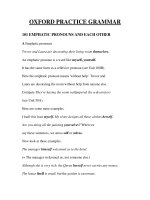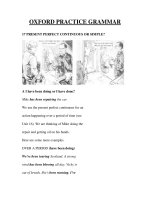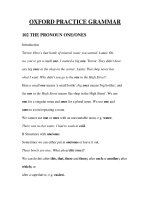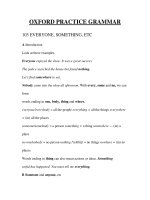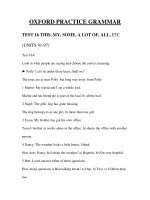OXFORD PRACTICE GRAMMAR 21
Bạn đang xem bản rút gọn của tài liệu. Xem và tải ngay bản đầy đủ của tài liệu tại đây (103.94 KB, 12 trang )
OXFORD PRACTICE GRAMMAR
21 REVIEW OF PRESENT AND PAST TENSES
A Introduction
Study the verb forms.
Claire is ready to go on safari.
Present continuous: She is waiting for her guide.
Present simple: She goes on holiday a lot.
Present perfect: She has bought a safari suit.
Present perfect continuous: She has been planning her
trip for months.
Past simple: She bought the suit last week.
Past continuous: She was going past Harrods when
she saw it in the window.
Past perfect: She had already decided that she
needed a safari suit. Past perfect
continuous: She had been looking for one
for a week or two.
B I am doing or I do? (Unit 6)
PRESENT CONTINUOUS PRESENT SIMPLE
We use the present continuous for an action now, We use the present simple
for repeated actions,
something we are in the middle of. things that happen again and again.
/ am writing a letter. ] write home every week.
Claire is wearing a safari suit. Tom never wears smart clothes.
We're getting lunch now. We usually get lunch at about one.
We use the present continuous for a feeling over a We normally use the
present simple for thought;
short period of time. and feelings, and for states and permanent facts.
Vicky is liking her course much better this year. Claire likes holidays.
Four times twelve makes forty-eight.
We use the present continuous for a temporary We use the present simple for
a permanent
situation or routine. situation or routine.
I'm very busy at the moment, so I'm getting up I usually get up quite late,
early this week.
C I have done or I did? (Units 14-15)
PRESENT PERFECT PAST SIMPLE
The present perfect tells us about the past and the The past simple tells us
about the past, a time
present. which is finished.
They have locked the door. No one can get in. They locked the door at ten
o'clock last night.
We use the present perfect for a state which has We use the past simple for a
state in the past,
gone on up to the present.
I've known him for ages. He's an old friend. I knew him when we were at
college together.
We use the present perfect for actions in a period We use the past simple for
actions in the past,
of time up to the present.
/ have seen the carnival several times. I saw the carnival several times as a
child.
D I have been doing or I have done? (Unit 17)
PRESENT PERFECT CONTINUOUS PRESENT PERFECT
We use the present perfect continuous for an We use the present perfect
simple for a complete
action over a period of time leading up to the action. We are thinking of the
result.
present. We are thinking of the action going on.
Daniel's tired. He's been working. At least he's earned some money.
I've been reading all afternoon. I've read 200 pages.
We've been staying here for a week/since
Thursday.
E I was doing or I did? (Unit 10)
PAST CONTINUOUS PAST SIMPLE
We use the past continuous for an action that we We use the past simple for
a complete action in
were in the middle of. the past or for a past state.
/ was reading the paper at half past ten. I left the house at half past ten.
Vicky had a headache.
We often use the past continuous and simple together when a shorter action
(simple) comes in the middle
of a longer one (continuous).
We were looking for the coffee bar when we met Emma. But we
use two past simple verbs for one action after another.
When we saw Rachel, she waved to us.
F I did or I had done? (Units 18-19)
We use the past simple to talk about a past situation and the past perfect for
things that happened earlier. I
threw the magazine away. I'd finished with it. When Sarah found the letter,
someone had already opened it.
When the new people moved in, the house had been empty for a year.
We can use when ... had done to say that one thing finished and then
something else happened.
When we'd paid the bill, we left the restaurant. But when one short action
comes straight
after another, we use the past simple for both.
When the firework went off, the dog ran away.
Compare these two sentences.
When we arrived, the others all left. (We arrived and then they left.) When
we arrived, the others had all left. (They left before we arrived.)
G I had been doing or I had done? (Unit 20)
We use these forms when we look back from a situation in the past.
PAS! PERFECT CONTINUOUS PAST PERFECT
We use the past perfect continuous for an action We use the past perfect
simple for a complete
over a period of time. We are thinking of the action. We are thinking of the
result,
action going on.

